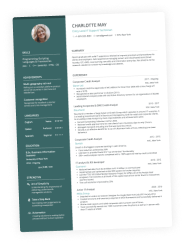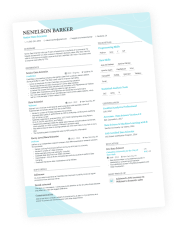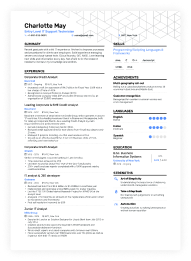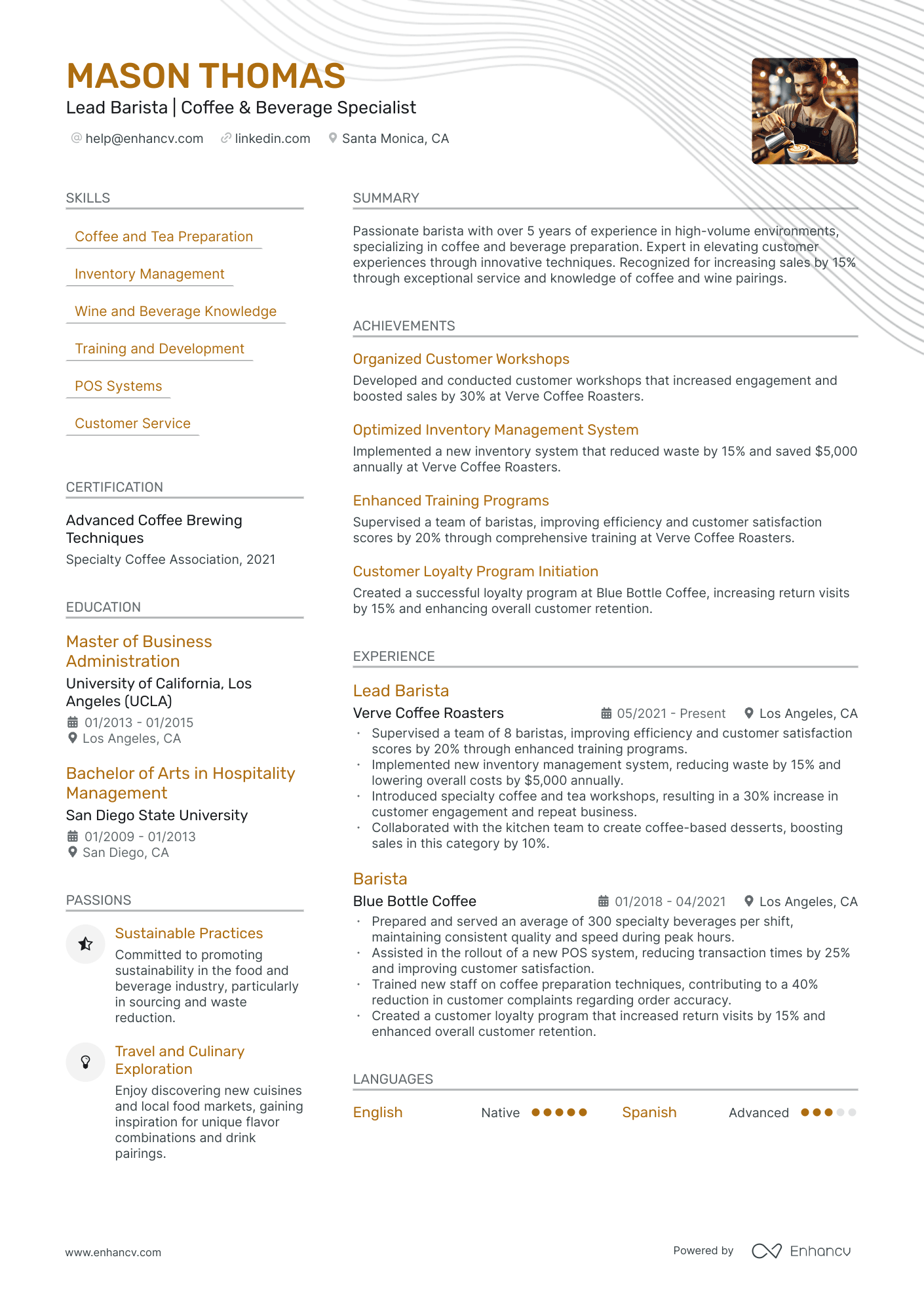You’ve probably heard of the STAR method being used to ace interview questions—but did you know it can work wonders on your resume, too?
The STAR method (Situation, Task, Action, Result) is a structured approach for writing resume content that shows hiring managers exactly what you’ve accomplished—and how. Unlike resumes that simply list responsibilities, a STAR-based resume highlights the steps you took and the outcomes you achieved, helping your experience come across as purposeful and results-driven.
In this article, we’ll walk you through how to apply this method using Enhancv’s STAR resume template. You’ll learn how to craft a resume that doesn’t just tell your story—it backs it up with evidence and builds trust with employers.
Key takeaways
- STAR is a writing approach that stands for Situation, Task, Action, Result and turns generic job duties into clear, result-focused accomplishments.
- Focus on outcomes—even if they aren’t numbers—to prove how you made a difference.
- STAR helps showcase your value with clarity—at any career level and at any stage of the job application process.
- You don’t need to label each STAR element—just weave them naturally into your resume.
- STAR works across all resume sections, from your summary to your experience and achievements.
- STAR, CAR, and XYZ are variations of the same storytelling formula—focus on the challenge, your actions, and the results to showcase value clearly.
Let’s start by breaking down what this method is all about.
What is the STAR method (and why it works on a resume)
The STAR method is a structured way to describe your past experiences by focusing on what you achieved—not just the tasks you performed.
The acronym stands for:
- Situation: What was the context or challenge?
- Task: What were you responsible for?
- Action: What did you do to address it?
- Result: What happened because of your action?
STAR resume formula
Use this simple sentence structure to build a strong, success-driven bullet point:
[Action Verb] + [Task or responsibility] by [Action you took / how you did it] resulting in [Quantifiable outcome or achievement].
Example:
Before:
“Handled customer complaints and processed refunds”.
After (STAR-based):
“Resolved 25+ customer complaints weekly (Task) by implementing a new ticketing system (Action), reducing average resolution time by 30% (Result).”*
*The Situation is implied (likely a high volume of customer complaints or an inefficient system), which is totally fine for resume bullets—brevity is key, and context can often be inferred.
See the difference? Instead of just listing what you did, STAR shifts the focus from duties to impact—and that’s exactly what hiring managers care about.
You might also come across a similar framework called the CAR method—Challenge, Action, Result. STAR and CAR are nearly identical in practice. The key is showing the challenge, your role in solving it, and the outcome you achieved.
STAR vs. CAR vs. XYZ: what’s the difference?
Call it STAR, CAR, or XYZ—the names may vary, but the goal stays the same: to tell a story that shows how you made a difference. STAR just happens to be the most popular kid in the acronym crowd.
Here’s a quick breakdown of how the three differ:
3 ways of framing achievements on a resume
| Method | What it stands for | Best used for | Example format |
|---|---|---|---|
| STAR | Situation, Task, Action, Result | Interviews, resumes, cover letters | “Improved onboarding time (Task) by launching a training portal (Action), cutting ramp-up time by 30% (Result).” |
| CAR | Challenge, Action, Result | Concise resume bullets or leadership stories | “Faced declining retention (Challenge), created personalized check-ins (Action), and improved retention by 20% (Result).” |
| XYZ | Accomplished X by doing Y as measured by Z (Google-style) | High-impact, metrics-heavy roles (tech, product, sales) | “Grew active users by 50% (X) through content optimization (Y), tracked in Mixpanel (Z).” |
Which one should you use? It depends on the space and narrative.
STAR is the most flexible—it works as a full story or a single bullet. XYZ is great when you have strong metrics. CAR is a quicker option when you need to stay brief but still show impact.
The key is to stay clear and outcome-focused. Whichever method you choose, make sure you’re showing what you did, how you did it, and why it mattered.
Do you need to label each STAR section on your resume?
Your resume isn’t an essay—it’s a highlight reel. You don’t need to spell out “Situation:” or “Task:” in each bullet point. The goal is to weave the STAR elements naturally into your experience, so your contribution shines through without calling attention to the structure.
STAR entries can take different forms on your resume—they might show up as part of your summary, a single bullet point, or a short series of bullets under one job. Sometimes, even one of the elements can be implied or combined with another. It’s not a rigid formula. What matters is that each part of the story fits naturally into the context and supports the point you’re making.
Now that we’ve clarified how the STAR method works, let’s look at what to keep in mind when using it to write your resume.
How to craft a resume using the STAR approach
Whether you're entry-level or experienced, the STAR method can help you write stronger resume content. You can use it in any section where you're talking about your work—the summary, achievements, or experience section bullets.
The process is the same:
- Study the job ad: Identify the key skills, responsibilities, and outcomes the employer is looking for.
- Tailor your content: Match your strengths to the job requirements and mirror the language thoughtfully. Use similar phrasing to show alignment—without sounding copy-pasted.
- Start with strong verbs: Lead with action words like developed, solved, launched, or improved. Stick to active voice to keep your tone confident and direct.
- Be brief: Keep it tight. One clear example per bullet or sentence is enough to spotlight your successes.
- Make the result count: Include numbers when possible—percentages, dollar values, time saved—to show measurable impact.
When used intentionally, the STAR (or CAR) method helps your resume speak in terms employers care about.
Not sure where to begin? Ask yourself:
- When did I solve a tricky problem at work?
- What did I improve or make more efficient?
- Did I help a team hit a goal faster—or make someone’s job easier?
- What’s one project I’m genuinely proud of, and what changed because of it?
If an example comes to mind, you’ve got the foundation for a strong STAR bullet.
PRO TIP
Some experts recommend front-loading accomplishments (starting with the result), while others prefer to back-load and build up to it. Both can work well—it depends on what reads best for your story.
What matters most is consistency. Pick one approach and apply it throughout your resume to keep the flow clean.
Here’s how the wording shifts depending on where you place the result:
Front-loaded:
“Reduced patient discharge time by 30% by streamlining post-operative care procedures in coordination with surgical and recovery teams”.
Back-loaded:
“Streamlined post-operative care procedures in coordination with surgical and recovery teams, reducing patient discharge time by 30%”.
If you're new to resume writing—or just want a reliable model to guide you—this simple STAR-based template is a great place to start:
STAR resume template (copiable)
Name Surname
Job Title
(000) 000-0XXX | your.name@enhancv.com | @LinkedIn | Location
Summary
Accomplished [job title] with [X] years of experience in [industry/field], known for delivering measurable results through strategic problem-solving and collaborative execution. Recognized for [key trait or strength] and delivering measurable outcomes in [relevant area]. Proven ability to [insert short STAR-style phrase: reduce wait times by 20%, improve system efficiency, increase customer satisfaction, etc.]
Experience
Job title
Company, Location
Month Year – Present
- [Action] + [Task] by [Action taken / how you achieved it] resulting in [Quantifiable or clearly stated Result].
- [follow the same structure]
- [follow the same structure]
Education
Degree
Institution
Graduated: Year
- Completed coursework in [relevant subject or skill area]
- Participated in [project, research, leadership activity]
Certifications
- [certification name], [issuing organization], [year]
Skills
- [hard skill 1] | [hard skill 2] | [hard skill 3] | [hard skill 4]
Languages
- [language 1] – [level]
- [language 2] – [level]
You can copy this template and build off of it regardless of the platform. Both Word resumes and resume apps with pre-made templates can be STAR-driven.
The biggest benefit of using the Enhancv Resume Builder is that its AI Assistant can quickly identify and rewrite your wording to show more value. In MS Word, you’ll have to do the heavy lifting yourself.
More STAR resume examples
The beauty of the STAR method is that it’s flexible—it doesn’t have to live only in your bullet points. You can apply the same principles of clarity, context, action, and successes across multiple sections of your resume.
Here’s how that might look.
Summary section
Instead of tossing in flat facts, try to be specific about what makes your experience stand out.
See how a marketing professional might do that in their summary:
This strategy works even better in your work history segment.
Experience section
What better place to add real substance to your accomplishments than the experience section of your resume?
Just keep in mind: Situation is often implied. You don’t need to follow the STAR pattern rigidly—trying to force all four elements into every bullet can clutter your message and waste valuable space.
Check out a good example from an Android developer’s application:
- •Redesigned the onboarding flow [Task] by integrating Jetpack Compose and conducting A/B testing [Action], which improved user retention by 18% within the first month [Result].
- •Collaborated with the cross-functional UX team to address a growing number of user complaints about playback errors [Situation], led the migration to ExoPlayer 2.0 [Action], reducing crash rates by 40% [Result].
- •Optimized API interactions [Task] by implementing Retrofit with Kotlin Coroutines [Action], resulting in 25% faster load times and a smoother in-app experience [Result].
Achievements section
This is the perfect spot to highlight standout moments in your career—things you’re genuinely proud of. Focus on showcasing impact with clarity and confidence, not cramming in every detail. A strong achievement speaks volumes, even in just one line.
Here’s an example from a student’s resume:
Whether you're adding impact to your summary, experience bullets, or achievements, the STAR method gives your resume structure, clarity, and credibility. The key is to stay flexible—use the elements where they fit naturally, and focus on outcomes that speak for themselves.
STAR resume bullet examples by profession
Wondering how STAR stories might show up in your industry? Here are a few one-line examples to help you connect the method to your field.
Technology
- Reduced app load time by 25% (Result) by rewriting critical API endpoints using asynchronous calls (Action).
- Caught and resolved a memory leak issue (Task) by implementing automated regression tests (Action), reducing crash rate by 40% (Result).
- Improved CI/CD pipeline (Task) by introducing GitHub Actions (Action), speeding up deployments by 30% (Result).
Healthcare
- Decreased average patient wait time by 20% (Result) by streamlining intake documentation and triage handoffs (Action).
- Implemented a new medication reconciliation checklist (Action), reducing discharge errors by 15% (Result).
- Led a hospital-wide training session on EHR best practices (Task/Action), cutting data entry time by over 10 hours per week (Result).
Retail & Hospitality
- Increased monthly upsells by 35% (Result) by training staff to promote bundles based on customer purchase history (Action).
- Handled a 20% spike in weekend foot traffic by reorganizing shift schedules and minimizing stockroom delays.
- Improved guest check-in time (Task) by automating ID verification at kiosks (Action), raising customer satisfaction scores by 18%.
Project Management
- Delivered a $600K product release 3 weeks early (Result) by refining sprint planning and risk mitigation tracking (Action).
- Resolved ongoing cross-team blockers (Task) by implementing a shared Asana dashboard (Action), reducing task overlap and delays (Result).
- Boosted stakeholder engagement by 40% (Result) through biweekly demo meetings and documented progress reports (Action).
Marketing
- Increased email campaign conversion rate by 22% (Result) after segmenting audiences by engagement level and tailoring CTAs (Action).
- Built a social strategy from scratch (Task) by auditing competitor content and testing 3 formats (Action), doubling organic reach in 60 days (Result).
- Reduced bounce rate on landing pages by 18% (Result) by redesigning CTA layout and streamlining form fields (Action).
Don’t see your industry? Use Enhancv’s AI Resume Builder to create STAR-powered content for your unique background.
Is your resume good enough?
Drop your resume here or choose a file. PDF & DOCX only. Max 2MB file size.
Common STAR method mistakes to avoid
Using the STAR approach on your resume can seriously boost your experience—but only if it’s used the right way.
Here are a few common missteps to watch out for:
- Too much setup, not enough outcome: It’s tempting to over-explain the situation or context, but resume space is limited. Hiring managers care more about what happened than the full backstory.
- Skipping the result entirely: A STAR bullet without an outcome reads more like a task list. Even if you don’t have hard numbers, you can still point to a clear benefit—think faster workflows, happier clients, or a smoother process.
- Trying to force all four STAR elements into every bullet: Not every bullet needs to show the full Situation, Task, Action, and Result in that exact order. Some parts can be implied or blended. The goal is clarity, not a rigid formula.
- Sounding too templated: If your STAR entry sounds like it came from a template, go back and personalize it. Specificity is what gives your resume credibility.
- Listing duties instead of outcomes: STAR is about showing how you made a difference—not what you were told to do. If your bullet could start and end with “Responsible for…” it’s not doing you any favors.
PRO TIP
The quickest way to test if a STAR bullet works? Ask yourself: “Does this show how I solved a problem or delivered value?” If not, refine it until it does.
Frequently asked questions on using the STAR method
Now, if you’re still wondering how to make it all work in practice, let’s tackle some common questions.
Can I use STAR for a cover letter?
Yes, and it works perfectly. A short STAR story can add depth to your cover letter, especially when you're explaining how you solved a problem or made a contribution. Just keep it concise and relevant to the job you're applying for.
What if I don’t have quantifiable results?
Not every achievement has a number attached to it. You can still demonstrate your influence through improved processes, positive feedback, or growth in responsibility. Focus on outcomes—even if they’re not measured in percentages or dollars.
What are the best ways to use the STAR method on a student's resume?
The STAR method is a great way for students to turn academic work, internships, and part-time jobs into impactful resume content. Focus on moments where you took initiative, solved a problem, or contributed to a result—even if it wasn’t in a full-time role. You don’t need years of experience to write resume bullets that show real value.
Should seasoned pros use the STAR approach?
Yes—especially them. Experienced professionals often have rich stories to tell, and a STAR-driven resume helps distill those into clear, focused narratives.
How do I choose the best STAR examples for my resume?
Start by reading the job ad carefully. Look for repeated themes—like collaboration, ownership, or problem-solving—and choose STAR examples that reflect those strengths. The better your stories match what the employer values, the more your resume will stand out.
Can I write STAR bullet points on a one-page resume?
Absolutely. In fact, the STAR method is ideal for one-page resumes because it helps you communicate more with less. A single well-crafted line can show what you did, how you did it, and what came of it—no fluff needed. When space is tight, STAR keeps your bullets focused on outcomes, and if the context is clear from your role or industry, you can prioritize the action and result without over-explaining.
Can I use the STAR method without job experience?
Yes—and you should. You don’t need a full-time job to write compelling STAR examples. Think about class projects, internships, volunteer work, or leadership roles—any situation where you took initiative, solved a problem, or contributed to a meaningful outcome can showcase your skills.
Should I use one STAR bullet per role or more?
There’s no rule here. You can use one standout example, or a few smaller ones—just make sure each bullet tells a different story. Repeating the same kind of task or outcome over and over doesn’t add much value.
How can I use the STAR method when changing careers?
The STAR method is a powerful tool for career changers because it focuses on how you think and what you achieve—not just where you’ve worked. Hiring managers and recruiters read STAR-style entries as signals of strategic thinking, accountability, and the ability to deliver results—qualities that matter across industries, regardless of your previous job title.
Conclusion
The STAR method isn’t just for interviews—it’s a powerful tool for building a resume that tells your story with intention and clear outcomes. By focusing on what you did, how you did it, and what came of it, you turn flat descriptions into persuasive proof of value. Whether you’re just starting out or have years of experience, STAR can help your resume stand out where it matters most.
Make one that's truly you.




